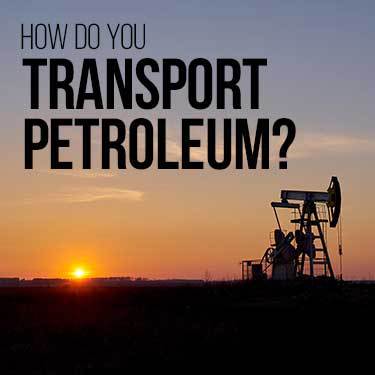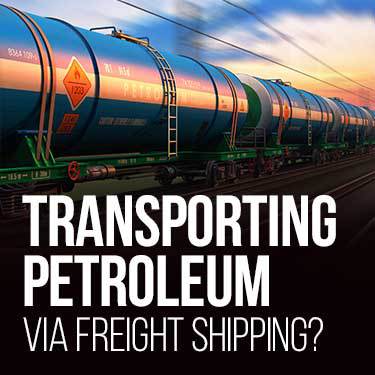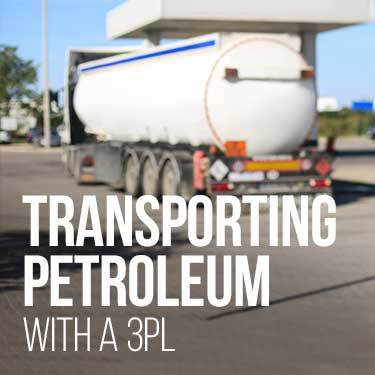Petroleum is the unrefined mix of hydrocarbons that are further refined into many oil-based products people use everyday — oil, gasoline and kerosene among them. Freight shipping petroleum to be turned into retail or wholesale products will be your best bet. Figuring out how is the bigger question.
Freight shipping petroleum is the act of transporting the liquid mixture to a refinery or storage area. Petroleum can be shipped by tanker truck, railroad, pipelines, and ocean tanker. Tanker trucks are a common method. A tanker truck can carry up to 7,500 gallons of petroleum.
Finding out more about how your petroleum will be shipped and also doing your due diligence in picking the right partner can really help make this a successful endeavor.
What is petroleum? To some folks, petroleum is liquid gold. To scientists, refineries, and others, petroleum is another word for crude oil. Like gold, petroleum comes from the earth, is expensive, and is hard to find.
Petroleum is a fossil fuel. It is formed within the Earth’s crust from ancient remains of plants, animals, and bacteria under intense heat and pressure. Today we rely on petroleum and crude oil to meet all kinds of industrial and scientific needs.
In fact, according to information from the U.S. Energy Information Administration, the uses for petroleum are varied and far-reaching. Uses for petroleum include:
The U.S. used 7.5 billion barrels of crude oil or petroleum in 2019. Of those almost half (45%) was turned into gasoline for vehicles; 20% went to distillate fuel for heating homes and more; and 8% was used to make jet fuel. The other 27% of the crude oil used went to other applications, including those mentioned above.
With such diverse uses, it is easy to see why freight shipping petroleum is a big deal in today’s industrial business world. Let’s learn more about oil and petroleum transport.

From the drilling rigs to a store to be sold, most people are concerned with having the ability to purchase the many petroleum products able to be produced. But how it travels from point A to point B is equally important to consider, especially if it’s part of your job to figure that out.
The four most common ways that petroleum transport occurs is by ocean tanker, truck tanker, pipelines and railroad. Pipelines and railroad are the most used but can’t always get the job done on their own, necessitating the use of trucks for at least part of the trip. The transport solution most used in these instances is called intermodal, meaning that two or more methods of transportation are used to complete a single shipment.
Other than a pipeline, where the petroleum is inside the pipe and travels that way, the other three types of transport will be in either large tanker containers or be shipped in barrels. Most of the recent safety rules set forth by the U.S. Department of Transportation’s Pipeline and Hazardous Materials Safety Administration (PHMSA) are centered around making railroad hauling of petroleum safer.
It is a fact: the cost of oil transportation varies by mode. While freight shipping petroleum and oil in a tanker truck is one option, this liquid can also be moved by pipeline, rail car, and barge.
But which of these methods for oil transport is the cheapest? If the cost -- not the destination -- is the only consideration, you might find that pipeline is the cheapest way to transport oil, according to information from Forbes.
Trucking might be among the most expensive method of oil and petroleum transport, but it also might be the most essential. Trucks are used for freight shipping petroleum from new basins or drill sites where pipelines and railroads are not yet established and when the liquid only needs to be moved a short distance. This means tanker trucks come in handy to make last-mile oil and petroleum deliveries and more.

Depending on where the petroleum is going and for what initial purpose will determine how and it is shipped to. The first way petroleum is shipped is to go to a refinery to be turned into another oil-based product. In this scenario, a tanker truck would be used. The reason a truck would be used is because it’s been determined that a pipeline or rail car is not practical for the trip.
If it is crude oil or has already been refined — let’s say, into gasoline — a tanker truck holding up to 7,500 gallons can make the trip from the oilfield to a refinery or to gas stations to refill their supply.
On the other hand, sometimes the petroleum in its natural state isn’t ready to be processed and needs to be stored in barrels for future usage. In this case, it could be freight shipped in barrels on the back of a traditional 18-wheeler and taken to a storage facility.
From the owner of the petroleum’s perspective, you need to make sure barrels are properly sealed and marked so that anyone handling the freight is reasonably able to take the appropriate precautions when in contact.
Customers tend to like using a truck or truck tanker because this method is readily available and is a true door-to-door solution often at very reasonable prices. While rail or ocean is also relatively inexpensive, a ship will still require another form of transport over land while a rail might be able to get your petroleum most of the way to its destination but not all the way.
The cost to transport oil can vary. While pipeline might be the cheapest method used to move petroleum, variables come into play when it comes to price. Distance, grades of crude oil being transported, and method of transport all influence cost.
Figures reported by Forbes suggest that it might cost between $2 and $4 per barrel to transport oil via pipeline. Freight shipping oil via rail is significantly more expensive and can cost $10 to $15 per barrel to move. Trucking is an even more expensive option and can vary.
The best way to determine the cost of freight shipping petroleum and oil is to reach out to a logistics partner for a freight rate quote. A skilled 3PL company should be able to work with you to meet your oil transport needs and help you get your goods on the road.

When looking for a company or driver to move your petroleum across the United States, there’s a likely chance that you’ll be getting price quotes from third-party logistics (3PL) company. A 3PL will offer freight transportation and many other services tied to that, like warehousing and order fulfillment.
But for the purpose of transporting petroleum, we’ll stick to the freight carrying aspect. The process begins with the customer getting a price quote from the 3PL. Once that occurs, the 3PL will match a driver with the job and it will be a normal truckload hauling. The whole process is not very complicated, but as the customer in this scenario, it’s your duty to both the person purchasing the petroleum and your own business to do some research on the company that will be freight shipping your load to see if they’re the best fit for the task.
While shopping shipping rates is a very smart business move, also consider what you’re receiving for what could be a cross-country trip where your petroleum might travel over 3,000 miles depending on the beginning and ending points of the haul. So while the cheapest rate might initially be the most attractive, the carrier’s reliability, extra services — whether it be customer-based or something like real-time freight visibility via GPS — and ability to undertake the task in the way that works best for you.
When you are prepared to begin freight shipping petroleum, look no further than R+L Global Logistics. We are a third-party logistics company that is an industry leader in the safe and efficient transportation of many commodities, including petroleum. So the next time you’re ready to send petroleum across the U.S., the choice is clear who you should choose.
There are many reasons why you should choose R+L Global Logistics for this important job. First, we have the equipment and skilled drivers available to transport the petroleum to the refineries and storage areas you need to access. Not only can we get it there for you, but we have an outstanding track on punctuality with our 99.5 percent on-time delivery rate.
Furthermore, we take each instance of truckload shipping we’re tasked with as seriously as you do, which is why we offer industry-leading customer service. No matter when a question or concern pops up, we’ll have someone available to assist you. Even if you just want to know where your petroleum is along the route, we provide real-time freight visibility so you can see its exact location.
Now that you’ve made the decision to start freight shipping petroleum, make another great choice to pick R+L Global Logistics as your truckload provider. For a free quote, call 866.353.7178 today.
Crude oil, also called petroleum, can be transported by pipeline, rail, barge, or truck. Each mode of transport has its own pros and cons.
In most cases, the cheapest way to transport oil or petroleum is via pipeline. This isn’t always the most flexible method of transport, though.
Freight shipping petroleum by truck is a good idea for last-mile deliveries, when crude oil needs to move from new basins, and in other situations.
R+L Global Logistics
315 NE 14th St., Ocala, FL 34470